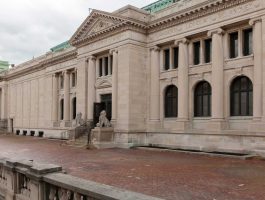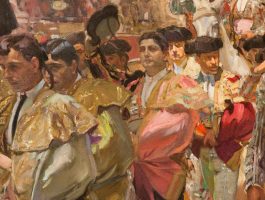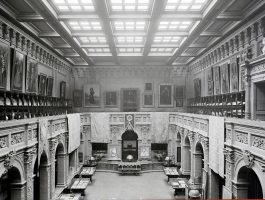Upon entering the Hispanic Society, visitors are brought into a Spanish Renaissance-style courtyard composed of ornate architectural terracotta rising 35 feet high. Made by the Perth Amboy Terra Cotta Company of New Jersey, the designs on the arcade columns are based on the carvings that surround the windows of the early 16th-century patio of the castle of Vélez-Blanco in the province of Almería, now installed at The Metropolitan Museum of Art. Other ornamental features such as the leaf scrolls, grotesques, and Roman trophies were adapted from ornaments typical of the early 16th century, while escutcheons above each arch bear the arms of Spanish provinces and cities. The floors are paved with unglazed, hexagonal floor tiles of red clay produced at the Moravian Pottery and Tile Works of Doylestown, Pennsylvania, which was founded by Henry Chapman Mercer, a major participant in the American Arts and Crafts movement. These tiles continue throughout the galleries and the Reading Room.
Prominently displayed in the Main Court is the Hispanic Society’s most famous painting, the full-length portrait of The Duchess of Alba (1797) by Francisco de Goya y Lucientes. Goya’s iconic portrait is accompanied by masterworks of Latin American painting that include St. Michael Striking Down the Rebellious Angels (Mexico, ca. 1650) by Sebastián López de Arteaga, Doña María Catalina de Urrutia (Puerto Rico, 1788) by José Campeche, and El costeño/Young Man from the Coast (Mexico, ca. 1843) by José Agustín Arrieta. Also on exhibition is an impressive selection of 16th through 18th-century polychrome wood and terracotta sculptures from Spain, Mexico, and Ecuador, that include Saint James Major (Mexico, 1575-1600); Virgin of the Immaculate Conception (Ecuador, 1700-1725); Saint Michael Archangel (Ecuador, 1700-1755); Saint Acisclus (ca. 1680) by Pedro de Mena; and The Rest on the Flight into Egypt (ca. 1690), The Ecstasy of Saint Mary Magdalene (ca. 1690), and The Mystical Marriage of Saint Catherine (ca. 1690) by Luisa Roldán. Completing the exhibition in the Main Court are fine examples of Spanish and Indo-Portuguese furniture, as well as a rare, early 15th-century Mudejar tin-glazed earthenware baptismal font from Toledo. Visitors may also find temporary exhibitions of select works from the collection in the Main Court.
On exhibition beneath the columned arcade of the Main Court are late Medieval and 16th-century altar panels, polychrome sculptures, alabaster tomb sculptures, as well as silverwork of the 15th to 18th centuries from Spain, Latin America, Portugal, and Goa. In the east arcade, the early 16th-century alabaster wall tombs of Gutierre de la Cueva, bishop of Palencia, and Mencía Enríquez de Toledo, Duchess of Alburquerque, from the Monastery of San Francisco at Cuéllar reveal the transition from Gothic to Renaissance in Spanish art and architecture. Leading to the Sorolla Vision of Spain Gallery, the west arcade displays important examples of silverwork from Spain, including a processional monstrance dated 1585 by Cristóbal Becerril from the parish church of San Juan at Alarcón (Cuenca, Spain), as well as secular colonial silverwork from Alto Peru, Mexico, and Goa. Of special note are two fine 18th-century examples of silverwork from Bolivia: a repoussé tray decorated with floral motifs and chincillas from the collection of Queen Charlotte, wife of George III; and an aquamanile for hot water in the form of a lion. Exhibited in the west arcade also are late medieval and Renaissance sculptures and altar panels: a polychrome wood relief of The Resurrection (ca. 1490) attributed to the sculptor Gil de Siloe; a polychrome wood statue of St. Martin (Cacabelos, León, ca. 1475-1500); the Ascension Panel from the Alterpiece of Saints Vincent and Giles (Valencia, ca. 1408) by Miguel Alcañiz; and the Altarpiece of the Two Saint Johns (Cuenca, ca. 1550) by Martín Gómez the Elder.




